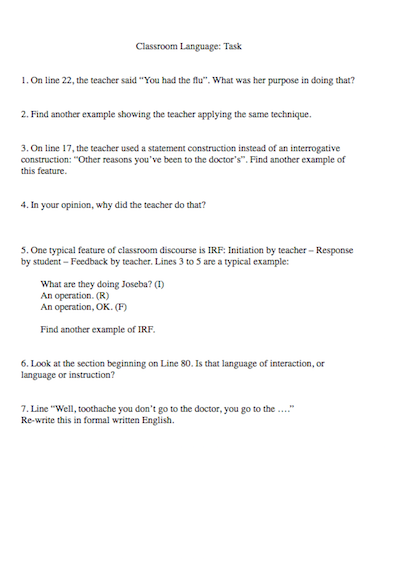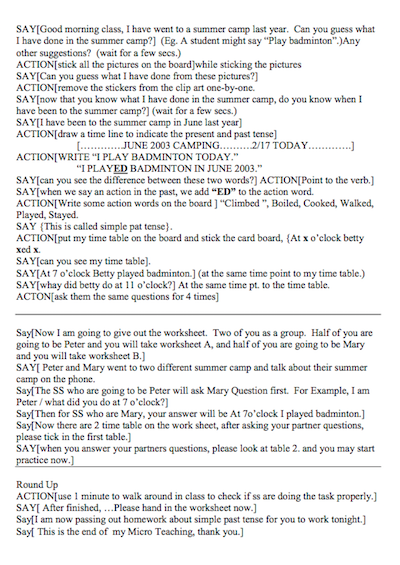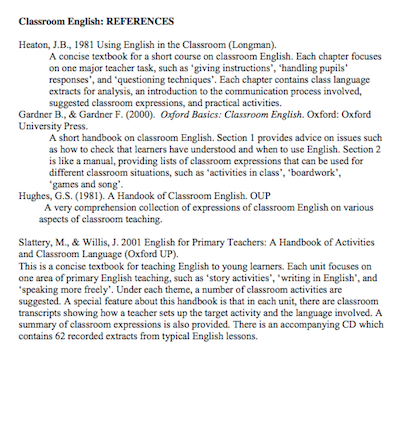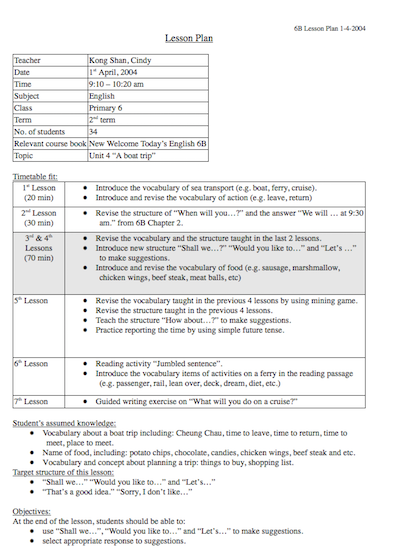Classroom Language and Classroom Interaction
Objective: To provide examples of language modification of classroom English, and presents techniques for effective classroom instruction and interaction.
Watch the following pre-class video, and then do the quiz. Please note the deadline for completing the pre-class Quiz.
Thinking about Classroom Language
View the first 2 minutes of a P4 lesson taught by a student teacher during Teaching Practice. This clip will be shown on the large screen. What are the problems with the teacher’s language? Be prepared to share your thoughts with the whole class.
Finding out about the Main Components of Classroom Language
One paper in the Language Proficiency Assessment for Teachers (LPAT) is Classroom Language Assessment (CLA). The main components assessed and the criteria used will give us an overview of what good classroom language constitutes.
Open the following file and study the assessment components and criteria for CLA.
Language of Instruction: Setting Up a Speaking Activity
In the video vignette below, the teacher is setting up a mingling activity. He uses a one-way, direct, way to explain the task. View this clip and think whether P4 students will understand the instructions.
In the video vignette below, the teacher is setting up the same mingling activity. But this time, he applies different techniques to help his students understand the instructions. View the clip, and identify the techniques used by the teacher. Note down the techniques he uses.
The Functions of Classroom Language
When teachers talk, they do not simply convey subject matter. Sometimes, they talk for different reasons, e.g., to motivate; to stimulate interest; to ascertain prior knowledge; to explain a concept; to check understanding; to stimulate further thinking; to correct a mistake, etc.
Do the following in pairs.
Study the lesson transcript (CL2). Then open the “Tasksheet Classroom Language for CL2”. Work through the discussion questions on the Tasksheet. Put down you answer on the WORD file, and save it using both your names. Then put it in the folder designated by the tutor.
Functions of Classroom Language in Action
View the following three clips. Which clip shows the teacher doing each of the following? Note the techniques used by the teacher.
- Accepting an answer from a student first but guiding the class towards the correct pronunciation.
- Wrapping up a lesson by summarizing the main language points.
- Helping students to understand a speaking task by breaking it down and assisting students with the language to use.
Questioning Techniques
Teachers often ask questions during a lesson, and for varied reasons, e.g.,
- To stimulate interest.
- To draw students’ attention to something.
- To gain students’ attention.
- To stimulate thinking.
- To check previous knowledge.
- To check understanding.
- To encourage higher-order thinking.
Watch the following classroom vignette, in which the teacher asks a lot of questions. Pay attention to:
- How he phrases the questions so that the students understand; and
- The functions of the questions.
Matching Interaction Patterns with Teacher Objectives
Different teacher objectives require different interaction patterns in order to realize the learning objectives.
Read the following extract (first page).
Then, work in pairs. Match the teacher objectives (Box 16.8) with the interaction patterns (Box 16.1).
To Explore Further
Scripting a lesson
Some student teachers script their upcoming lessons so that they can be sure students can follow their classroom language. The following lesson script was used by a student teacher, Betty, for a lesson during Teaching Practice.References on Classroom Language
English for Classroom Interaction from the 2004 Curriculum
Interaction patterns stated in a lesson plan
The following lesson plan for a double lesson was prepared by student teacher Cindy Kong. This lesson contained many steps. Note how the student teacher indicated the interaction pattern for each step.Teacher-active vs Student-active activities
It is advisable to have an appropriate balance of teacher-active and student-active activities, with reference to the objectives of the lesson. It may also be necessary to vary between teacher-active and student-active activities so as to sustain students’ interest and attention.The following reading provides an overview of activities which are teacher-active and those which are student-active.




